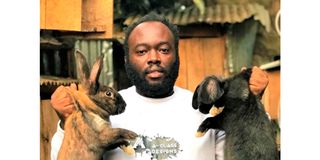The making of a city rabbit king

Alee Kagwa Waweru holds different breeds of his rabbits in Umoja, Nairobi.
Alee Waweru holds two huge rabbits on his farm in Umoja, Nairobi, comparing their weight.
The graphic designer, who runs A-Class Designs, nods his head knowing that the rabbits are over 1.5kg thus ready for market.
Waweru, whose farm is known as A-Class Rabbits, keeps a variety of breeds, a venture he started in 2017.
“When I started, I was keeping rabbits for fun because I loved them since I was a child, until someone came here and bought all my four rabbits at Sh2,050 each. This made me turn my hobby into a business,” says Waweru.
Also Read: Why caged birds suffer paralysis
To go commercial, he bought three three-month-old kits – a male and two females, at Sh1,500 each.
“I then constructed more cages and kept on adding until I now have 40. I invested over Sh100,000 into the business,” says Waweru, adding he watched YouTube videos and joined various Facebook and WhatsApp rabbit groups for lessons.
The farmer currently keeps100 rabbits, having slaughtered some for sale. The breeds are California white, New Zealand white, Checkered giants, English spot, Dutch, Flemish giants, Chinchilla, Havana, Angora, Hyla Max, Palomino, Kenya white, Cinnamon, Earlop and Silver marten.
“Mature male rabbits stay alone in the cages. Males are very territorial. However, a normal cage holds three mature rabbits and about eight kits.”
He feeds his rabbits mainly hay and pellets twice a day as well as greens like sukuma wiki and cabbages once a week and water daily. He buys hay and pellets from agrovets and the greens from the market.
“I have not employed anyone to take care of the rabbits, my wife and I plan and take turns to feed them and clean the hutches,” says Waweru, noting he keeps the various breeds to satify customer preferences.
According to him, a rabbit takes four months to attain the slaughter weight and about five months to mature. “Most of my rabbits kindle up to 12 kits but I had one that gave birth to 14 at once.”
To curb inbreeding, the farmer keeps records of every animal using a computer software. The records help him identify the parents and the kits, keeping track of them so that he doesn’t serve the females with their parents and vice versa. High cost of commercial rabbit pellets and hay are one of his biggest challenges.
“There was a time we used to buy a 50kg bag of pellets at Sh1,800, now it is Sh2,500 and hay was Sh200 and but now it gets at Sh350.”
Waweru, whose compound is about eighth-acre, keeps the animals in his backyard.
“Cleanliness is the only way to curb foul smell as that can be a challenge with neighbours. We wash the pens once per week with water and sweep regularly,” he says, noting mites and ear canker disease can be challenge.
He sells the animals at between Sh1,000 and Sh5,000 depending on the breed and age through WhatsApp and Facebook groups as other buyers come through referrals.
“To make more cash, I don’t sell rabbit meat per kilo. I sell full rabbits that are 1.2kg to 1.5kg. Cooked goes at Sh1,500 and non-cooked at Sh1,200,” explains Waweru, who in a good month sells up to 20 animals.
He collects manure and ferries it upcountry for use on their vegetable farm since he has not found good market in Nairobi.
Dr Jecinta Mwirigi, an animal production specialist, notes that majority of rabbit farmers use non-conventional methods to treat pests, in particular mange mite infestation.
“Mite infestation in rabbits is prevalent, affecting the animals as much as digestive system diseases. Mites cause severe skin condition (mange). There are three common mange mite species.
"First is the ear canker (psorsoptic mange), whose clinical manifestation is infection of the ears leading to intense scratching, redness, crustiness on the inner and outer ear and ear canal, head shaking, foul smelling discharge and drooping of the affected ears. Then there are the Sarcoptes and Cheyletiella mites,” says Dr Mwirigi.
She observes that mange mites are a highly contagious condition and transmission of the parasites is through direct contact between infected and clean animals.
“Equipment used in rabbit production can also transfer the parasites from one farm or animal to another. Sarcoptes mites also affect humans, causing transient itching. Factors associated with rabbit mites include purchase of initial/replacement stock, housing (design, construction and maintenance), feeding, production size, use of non-conventional methods, limited consultation of professionals and unavailability of drugs specially formulated for the parasites.”
Buying stock from neighbours is one way of spreading mange mites, she notes. Therefore, one should buy the animals from certified breeders who have strict disease control measures.
“Poorly lit and inadequately ventilated houses are a risk factor for mite infection. Liquid paraffin alone can be used to treat mange mites by applying it on the affected area daily for 21 days. The disadvantage of this method is that the condition tends to recur after some time.”
Waweru advises that to successfully keep rabbits, one must love them. “Don’t get into rabbit farming thinking you will be a millionaire in a short time; it takes patience and hard work. Every job has its challenges and this one is no exception,” advises the father of one.





